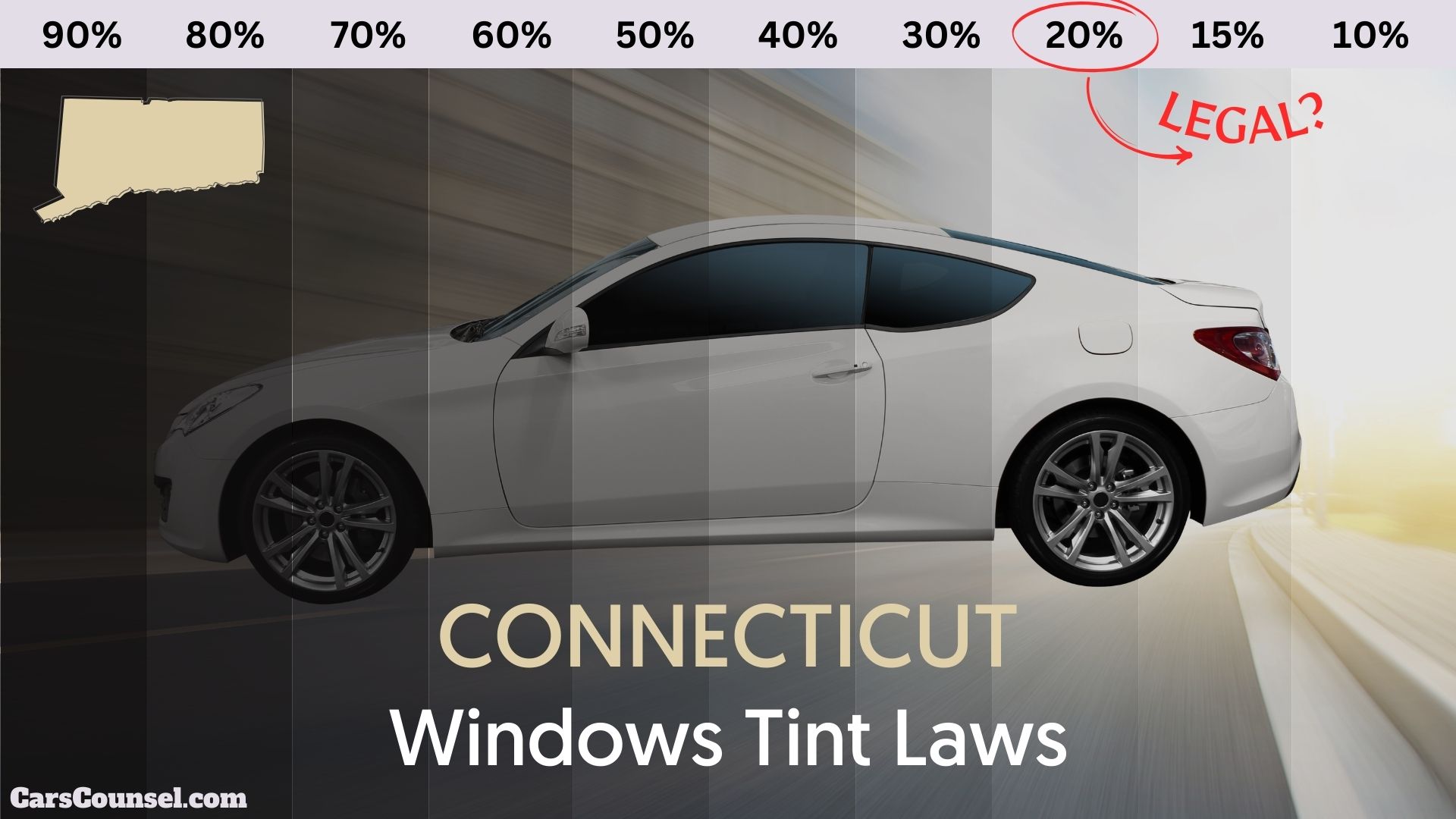As you consider tinting your vehicle’s windows in Connecticut, it’s essential to understand the state’s specific regulations to avoid fines and potential vehicle impoundment. You’ll need to certify your front side windows allow at least 35% of visible light to pass through, while rear windows can have a slightly darker tint.
But that’s not all – there are also rules governing reflectance, and certain medical conditions may qualify for exemptions. Are you aware of the specific guidelines and penalties that apply to your vehicle?

Quick Navigation
Window Tint Darkness Regulations
In regards to window tinting, one of the most vital factors to ponder is the darkness of the tint.
As far as Connecticut window tint laws are concerned, you need to know what’s allowed. The tint darkness is measured by Visible Light Transmission (VLT), which is the percentage of light that passes through the tint.
For your front side windows, the VLT must be at least 35%, meaning the tint can’t be too dark. Your rear window, on the other hand, can have a tint with a VLT of up to 35%.
It’s essential to guarantee your window tinting complies with these window tinting laws to avoid any issues. Always opt for a non-reflective tint to stay within the allowed limits.
[carscounsel_tint_calculator show_state=”true” default_state=”CT”]
Window Tint Reflection Laws
Beyond the darkness of the tint, another crucial aspect of window tinting laws in Connecticut is the reflection level.
You need to guarantee your tint doesn’t reflect too much light, which can obstruct the view of other drivers. In Connecticut, the laws dictate that your window tint mustn’t have a reflectance of more than 13% on the windshield and front side windows.
This means that no more than 13% of the light that hits the glass can be reflected. For the rear window and rear side windows, the reflectance isn’t restricted, but the VLT (Visible Light Transmission) must still meet the minimum allowed percentage.
Always verify the Connecticut laws and regulations before applying a tint to your window to avoid any issues.
Connecticut Window Tint Exemptions
You’ve verified your window tint meets Connecticut’s reflection standards, but you might be wondering if there are any exceptions to these rules.
Connecticut tinting laws do provide window tint medical exemptions for individuals who require a darker window due to a medical condition.
To qualify, you’ll need to obtain a Special Permit for Exemption from the Commissioner of Motor Vehicles.
This permit allows you to install a window tint with a lower visible light transmission, even though Connecticut law allows only 3% light transmission for non-exempt vehicles.
Be sure to review the Connecticut window tint rules and Tint Regulations to understand the requirements for obtaining a window tint law permit.
Window Tint Violation Penalties
Because window tint regulations are strictly enforced in Connecticut, it’s crucial to understand the penalties for non-compliance.
If you’re caught with illegal tint, you’ll receive a written warning and have 60 days to correct the issue. Failure to do so will result in fines: $150 for the first offense, $250 for the second, and $350 for subsequent violations.
Additionally, your vehicle may be impounded. Ignoring window tint laws and regulations can lead to legal consequences, including fines, penalties, and even temporary loss of your vehicle.
To avoid these penalties, confirm your window tint complies with Connecticut state laws, which dictate the allowed level of darkness and reflectivity.
Connecticut Window Tint Rules
In accordance with Connecticut state laws, your vehicle’s window tint must meet specific requirements to avoid penalties and fines.
For sedan cars and SUVs, legal tinting is required on the rear side windows, which must allow at least 35% of visible light.
The window tint colors should be non-reflective, with a tint reflection of no more than 3%.
Any darkness or tinting regulations that don’t meet these standards are prohibited.
Connecticut window tinting laws are strict, and it’s essential to comply to avoid penalties.
Guarantee your vehicle’s window tint meets these requirements to stay within the law.
Verify that your vehicle’s window tint adheres to these standards to avoid legal issues.
Tint Law References
General Statutes of Connecticut, Title 13b, Chapter 246, Section 14-99g
Quick Reference on Tinted Windows (Connecticut DMV)
Medical Exemption Info
Connecticut Application & Special Permit for Exemption from Tinted Window Requirements
Car Window Tinting Laws By State
Click on the state you’re interested in for a complete guide to its tint laws and regulations. If you spot any errors, let us know through our contact page.
| State | Front Side Windows | Back Side Windows | Rear Windows | Windshield |
|---|---|---|---|---|
| Alabama | 32% | 32% | 32% | 6 inches |
| Alaska | 70% | 40% | 30% | 5 inches |
| Arizona | 33% | ANY | ANY | tinting allowed to the top of the manufacturer’s as-1 line |
| Arkansas | 25% | 25% | 10% | 5 inches |
| California | 70% | ANY | ANY | 4 inches |
| Colorado | 27% | 27% | 27% | 4 inches |
| Connecticut | 35% | 35% | ANY | non-reflective tint above the as-1 line top 6 inches |
| Delaware | 70% | ANY | ANY | non-reflective tint above the as-1 line top 6 inches |
| Florida | 28% | 15% | 15% | non-reflective tint above the as-1 line |
| Georgia | 32% | 32% | 32% | 6 inches |
| Hawaii | 35% | 35% | 35% | Non-reflective tint is allowed on the top 4 inches of the windshield |
| Idaho | 35% | 20% | 20% | non-reflective tint above the as-1 line |
| Illinois | 35% | 35% | 35% | 6 inches |
| Indiana | 30% | 30% | 30% | non-reflective tint above the as-1 line |
| Iowa | 70% | ANY | ANY | non-reflective tint above the as-1 line |
| Kansas | 35% | 35% | 35% | non-reflective tint above the as-1 line |
| Kentucky | 35% | 18% | 18% | non-reflective tint above the as-1 line |
| Louisiana | 40% | 25% | 12% | non-reflective tint above the as-1 line top 6 inches |
| Maine | 35% | 35% | 35% | top 4 inches |
| Maryland | 35% | 35% | 35% | top 5 inches |
| Massachusetts | 35% | 35% | 35% | top 6 inches |
| Michigan | 35% | ANY | ANY | top4 inches |
| Minnesota | 50% | 50% | 50% | Top 6 inches |
| Mississippi | 28% | 28% | 28% | non-reflective tint above the as-1 line top 5 inches |
| Missouri | 35% | ANY | ANY | non-reflective tint above the as-1 line top 6 inches |
| Montana | 24% | 14% | 14% | non-reflective tint above the as-1 line top 6 inches |
| Nebraska | 24% | 20% | 20% | top 6 inches or as-1 line, whichever comes first |
| Nevada | 35% | ANY | ANY | non-reflective tint above the as-1 line top 6 inches |
| New Hampshire | 35% | 35% | 35% | Allowed for the manufacturer’s AS-1 line |
| New Jersey | Illegal | ANY | ANY | Top 6 inches |
| New Mexico | 20% | 20% | 20% | 5 inches or as-1 line, whichever comes first |
| New York | 70% | 70% | 70% | top 6 inches |
| North Carolina | 35% | 35% | 35% | non-reflective tint above the as-1 line top 6 inches |
| North Dakota | 50% | ANY | ANY | Top 6 inches |
| Ohio | 50% | ANY | ANY | Top 5 inches |
| Oklahoma | 25% | ANY | ANY | 5 inches or as-1 line, whichever comes first |
| Oregon | 35% | 35% | 35% | Top 6 inches |
| Pennsylvania | 70% | 70% | 70% | Top 3 inches |
| Rhode Island | 70% | 35% | 35% | non-reflective tint above the as-1 line top 6 inches |
| South Carolina | 27% | 27% | 27% | non-reflective tint above the as-1 line top 6 inches |
| South Dakota | 35% | 20% | 20% | non-reflective tint above the as-1 line top 6 inches |
| Tennessee | 35% | 35% | 35% | non-reflective tint above the as-1 line top 6 inches |
| Texas | 25% | 25% | 25% | 5 inches or as-1 line, whichever comes first |
| Utah | 43% | ANY | ANY | non-reflective tint above the as-1 line top 4 inches |
| Vermont | 70% | ANY | ANY | ILLEGAL |
| Virginia | 50% | 35% | 35% | non-reflective tint above the as-1 line top 6 inches |
| Washington | 24% | 24% | 24% | Top 6 inches |
| West Virginia | 35% | 35% | 35% | Top 5 inches |
| Wisconsin | 50% | 35% | 35% | non-reflective tint above the as-1 line top 6 inches |
| Wyoming | 28% | 28% | 28% | Top 5 inches or as-1 line, whichever comes first |

